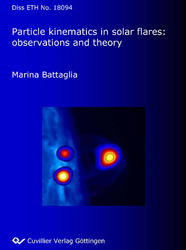| Fachbereiche | |
|---|---|
| Buchreihen (96) |
1378
|
| Nachhaltigkeit |
3
|
| Gesundheitswesen |
1
|
| Geisteswissenschaften |
2363
|
| Naturwissenschaften |
5406
|
| Mathematik | 229 |
| Informatik | 319 |
| Physik | 980 |
| Chemie | 1363 |
| Geowissenschaften | 131 |
| Humanmedizin | 243 |
| Zahn-, Mund- und Kieferheilkunde | 10 |
| Veterinärmedizin | 108 |
| Pharmazie | 147 |
| Biologie | 835 |
| Biochemie, Molekularbiologie, Gentechnologie | 121 |
| Biophysik | 25 |
| Ernährungs- und Haushaltswissenschaften | 45 |
| Land- und Agrarwissenschaften | 1004 |
| Forstwissenschaften | 201 |
| Gartenbauwissenschaft | 20 |
| Umweltforschung, Ökologie und Landespflege | 148 |
| Ingenieurwissenschaften |
1791
|
| Allgemein |
97
|
|
Leitlinien Unfallchirurgie
5. Auflage bestellen |
|
Erweiterte Suche
Particle kinematics in solar flares: observations and theory
Marina Battaglia (Autor)Vorschau
Inhaltsverzeichnis, Datei (41 KB)
Leseprobe, Datei (140 KB)
This thesis is devoted to the study of particle acceleration and propagation processes in solar flares.
Solar flares are amongst the most powerful and energetic activity phenomena our Sun exhibits. They release energy of the order of 1032 erg in seconds to minutes. In the process, electrons and protons are accelerated to relativistic energies, making flares very efficient particle accelerators. The most compelling observational signatures of flares can be found in X-rays and extreme ultra-violet wavelengths. Due to atmospheric absorption, those wavelengths can only be studied from space. Since the beginning of the space age, countless flares have been observed by satellites.
The present work is largely based on observations by the Ramaty High Energy Solar Spectroscopic Imager (RHESSI), an X-ray satellite which has been observing
the Sun since February 2002. It is a NASA mission with substantial Swiss hardware and software contribution.
Using RHESSI observations of flares of different intensity, a deeper understanding of the particle transport and energy transport processes in flare loops, as well as the acceleration site and acceleration mechanism is sought. The time evolution of images and spectra is studied along with the quantitative relations between X-ray sources observed in the corona (coronal sources) and from the chromosphere (footpoints). The spectral relations found between coronal sources and footpoints are compared to the so-called ``intermediate thin-thick target model’’, which was based on observations by the satellite Yohkoh. We show that the spectral relations between coronal sources and footpoints observed with RHESSI cannot be explained by the intermediate thin-thick target model. In a next step, return currents in the flare loop were considered. With this extension to the existing model, the spectra of the coronal source and the footpoints, as well as the relations between them can be explained, indicating the importance of return currents in flare loops.
In a second part, observations of so-called ``pre-flares’’ are presented. This earliest phase of a flare cannot be explained by the standard flare model of chromospheric evaporation which involves energy transport and deposition in the chromosphere by beams of accelerated electrons. In pre-flares, an increase in density and emission measure is observed, indicating that chromospheric evaporation is occurring. However, no observational signatures of fast electrons are found. We show that if energy is transported by means of thermal conduction instead of an electron beam, the observations can explained.
| ISBN-13 (Printausgabe) | 3867278806 |
| ISBN-13 (Printausgabe) | 9783867278805 |
| ISBN-13 (E-Book) | 9783736928800 |
| Buchendformat | A5 |
| Sprache | Englisch |
| Seitenanzahl | 162 |
| Auflage | 1 Aufl. |
| Band | 0 |
| Erscheinungsort | Göttingen |
| Promotionsort | ETH Universität Zürich |
| Erscheinungsdatum | 05.02.2009 |
| Allgemeine Einordnung | Dissertation |
| Fachbereiche |
Physik
|








